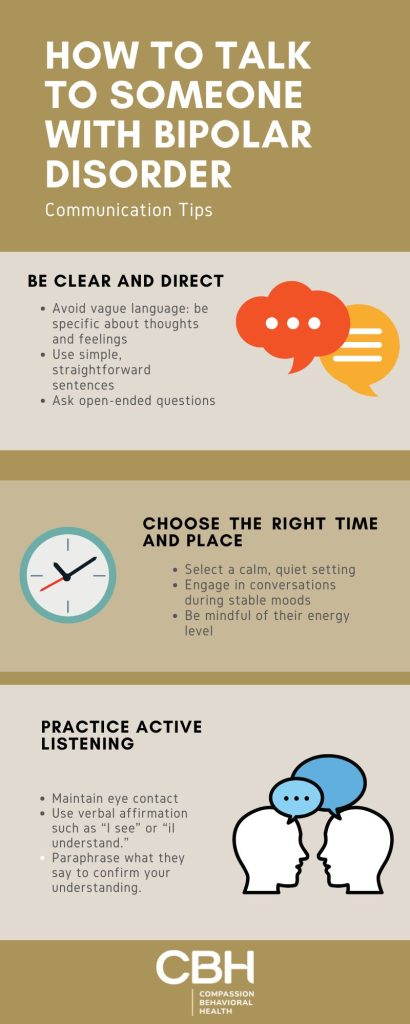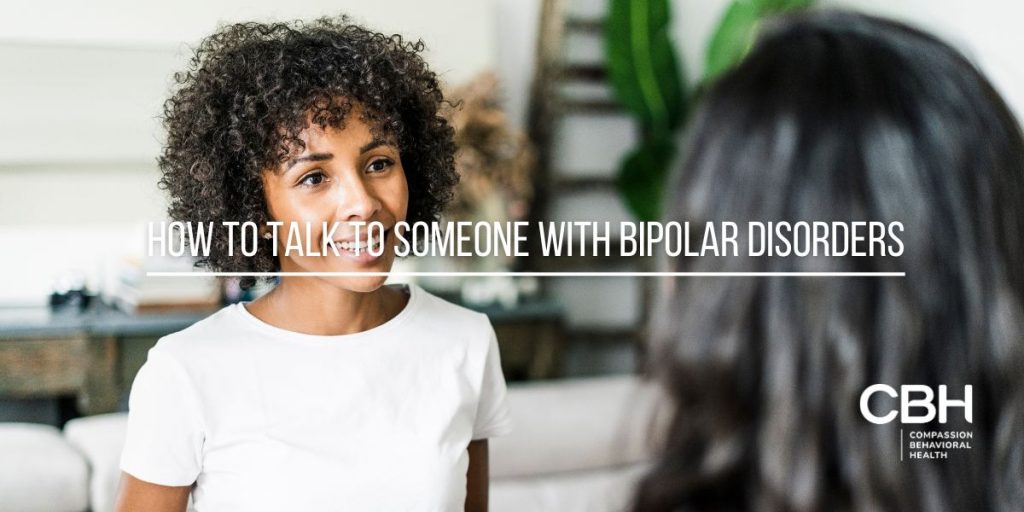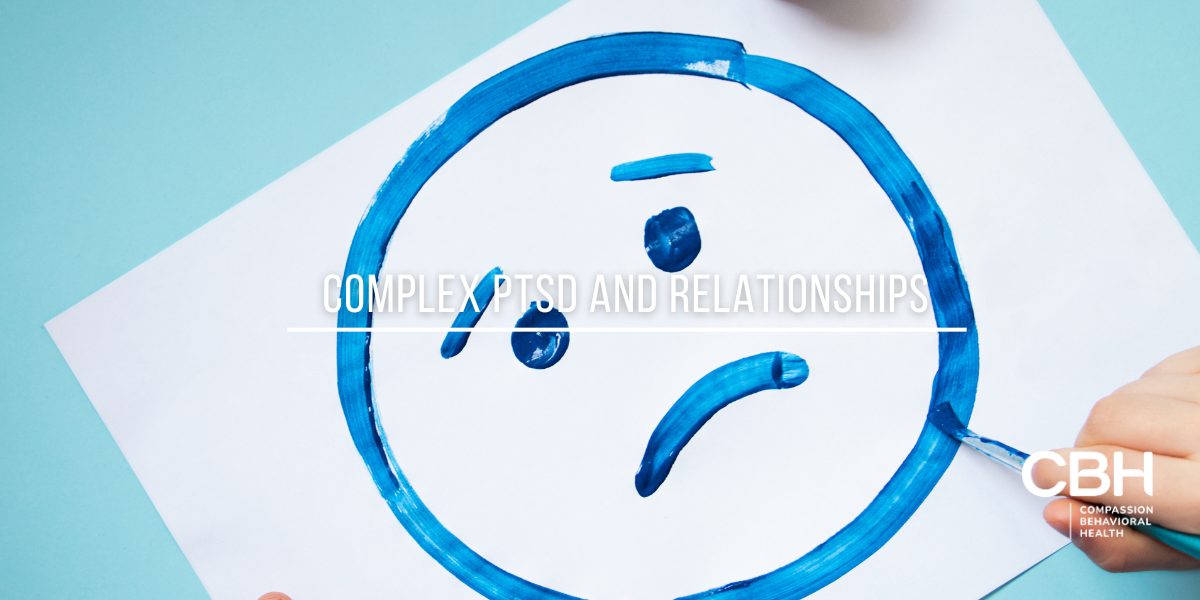Communicating with someone who has bipolar disorder can be challenging, but it is also an opportunity to provide support and understanding. This article aims to equip you with effective communication strategies that foster a positive environment for individuals living with bipolar disorder. By understanding their experiences and employing thoughtful communication techniques, you can help create a supportive atmosphere that encourages open dialogue.
Understanding Bipolar Disorder
Bipolar disorder is a mental health condition characterized by extreme mood swings, including emotional highs (mania or hypomania) and lows (depression). These mood changes can affect energy levels, activity, sleep patterns, and the ability to think clearly. Understanding the nature of the disorder is crucial for effective communication. The complexity of bipolar disorder often means that individuals may experience these mood swings in cycles, which can vary in duration and intensity. Some may have episodes that last for days or weeks, while others might experience rapid cycling, where they can shift between moods several times in a single day. This variability can make it challenging for both the individual and their loved ones to predict behavior and reactions, emphasizing the need for patience and understanding.
Recognizing the Symptoms
Being aware of the symptoms associated with bipolar disorder can help you navigate conversations more effectively. Common symptoms include:
- Manic episodes: Increased energy, reduced need for sleep, and impulsive behavior.
- Depressive episodes: Feelings of sadness, hopelessness, and a lack of interest in activities.
- Mixed episodes: Symptoms of both mania and depression occurring simultaneously.
Recognizing these symptoms can help you tailor your communication style to meet the individual’s current emotional state. For instance, during a manic episode, the person may exhibit heightened creativity and enthusiasm, which can be harnessed positively. Conversely, during depressive phases, they may require more gentle encouragement and understanding. Furthermore, being aware of triggers—such as stress or significant life changes—can also aid in fostering supportive interactions, as these factors can exacerbate symptoms and lead to more pronounced mood shifts.
The Importance of Empathy
Empathy is a cornerstone of effective communication. It involves understanding and sharing the feelings of another person. When talking to someone with bipolar disorder, showing empathy can help them feel validated and supported. Consider the following:
- Listen actively without interrupting.
- Offer reassurance and support without judgment.
- Acknowledge their feelings, even if you don’t fully understand them.
Additionally, it is essential to recognize that empathy goes beyond just verbal communication; nonverbal cues, such as maintaining eye contact and using a gentle tone, can significantly enhance the feeling of support. Engaging in conversations that allow the individual to express their thoughts and emotions freely can foster a deeper connection. Moreover, educating yourself about bipolar disorder can further enhance your ability to empathize, as it equips you with a better understanding of what the individual may be experiencing. This knowledge can help dispel myths and reduce stigma, creating a more open and accepting environment for those affected by the disorder.
Effective Communication Strategies
When engaging in conversations with someone who has bipolar disorder, employing specific strategies can enhance understanding and connection. Here are some effective communication tips:

Be Clear and Direct
Clarity is essential when communicating with someone who may be experiencing mood swings. Here’s how to ensure your message is clear:
- Avoid vague language; be specific about your thoughts and feelings.
- Use simple, straightforward sentences.
- Check for understanding by asking open-ended questions.
Being direct can help prevent misunderstandings and ensure that both parties are on the same page. Additionally, it can be beneficial to use “I” statements to express your feelings without placing blame. For example, saying “I feel worried when you don’t respond to my messages” can be more effective than “You never reply to me.” This approach fosters a non-defensive atmosphere and encourages open dialogue.
Choose the Right Time and Place
The timing and environment of a conversation can significantly impact its effectiveness. Consider the following factors:
- Choose a calm, quiet setting free from distractions.
- Engage in conversations during stable moods, avoiding times of high emotional intensity.
- Be mindful of their energy levels; if they seem fatigued or overwhelmed, it may not be the best time to talk.
Creating a conducive environment can facilitate a more productive dialogue. Furthermore, it may help to establish a routine for discussions, such as setting aside time each week to check in. This consistency can provide a sense of security and predictability, making it easier for both parties to engage in meaningful conversations.
Practice Active Listening
active listening is a crucial skill when communicating with someone who has bipolar disorder. It involves fully concentrating, understanding, responding, and remembering what the other person is saying. To practice active listening:
- Maintain eye contact to show engagement.
- Use verbal affirmations like “I see” or “I understand” to encourage them to continue.
- Paraphrase what they say to confirm your understanding.
This approach not only helps in understanding their perspective but also shows that you value their thoughts and feelings. Additionally, it can be helpful to ask clarifying questions if something isn’t clear. For instance, you might say, “Can you tell me more about how you felt during that situation?” This not only deepens the conversation but also demonstrates your genuine interest in their experiences. By fostering an atmosphere of empathy and understanding, you can help build a stronger, more supportive relationship.
Supporting During Episodes
During manic or depressive episodes, communication may require additional sensitivity and care. Here are strategies for supporting someone during these times:
During Manic Episodes
When someone is experiencing a manic episode, they may exhibit heightened energy and impulsivity. Here’s how to communicate effectively:
- Stay calm and composed; your demeanor can influence their mood.
- Set boundaries gently, as they may be more likely to engage in risky behavior.
- Encourage them to express their feelings, but guide the conversation back to reality if it becomes disjointed.
Providing a sense of stability can help them feel more grounded during these times. It’s also important to recognize that their thoughts may be racing, leading to a scattered focus. You might consider using visual aids or written notes to help clarify points and keep the conversation on track. Additionally, engaging them in physical activities, such as a walk or light exercise, can help channel their excess energy in a positive direction while also providing an opportunity for connection.
During Depressive Episodes
Conversing with someone in a depressive state can be challenging. Here are tips for effective communication:
- Be patient; they may struggle to articulate their feelings.
- Offer your presence without pressure to talk; sometimes, just being there is enough.
- Encourage them to share their thoughts but avoid pushing them to open up if they’re not ready.
Creating a safe space for them to express themselves can be incredibly beneficial. It can also help to engage them in low-key activities that require minimal effort, such as watching a favorite movie or listening to music together. These shared experiences can provide comfort and a sense of normalcy. Additionally, consider checking in on their daily routines, as small gestures like preparing a meal or helping with chores can alleviate some of the burdens they may feel during these tough times, fostering a sense of support and care.
Encouraging Professional Help
While your support is invaluable, it’s essential to encourage professional help when needed. Here’s how to approach this sensitive topic:
Recognizing When to Suggest Help
There may be times when it becomes clear that professional assistance is necessary. Signs include:
- Persistent mood swings that interfere with daily life.
- Increased isolation or withdrawal from social activities.
- Expressions of hopelessness or thoughts of self-harm.
Being aware of these signs can help you approach the topic of professional help with sensitivity. Additionally, it’s important to note that these signs can manifest differently in each individual. For instance, someone may exhibit irritability or anger instead of sadness, which can sometimes be overlooked. Understanding the nuances of mental health can empower you to recognize when someone may be struggling, even if they don’t openly express it.
How to Approach the Topic
Suggesting professional help can be daunting, but it’s crucial for their well-being. Here are some ways to approach this conversation:
- Express concern for their well-being rather than focusing on their behavior.
- Share information about mental health resources and professionals.
- Offer to help them find a therapist or accompany them to appointments if they’re comfortable.
Framing the conversation around care and support can make it easier for them to consider seeking help. It’s also beneficial to share personal experiences or stories of others who have sought help and found it beneficial. This can normalize the idea of reaching out for assistance and reduce any stigma they may feel. Moreover, discussing the various types of therapy available—such as cognitive behavioral therapy, mindfulness practices, or group therapy—can help demystify the process and make it feel less intimidating. By providing a supportive environment and showing that seeking help is a sign of strength, you can encourage them to take that important first step toward healing.
Building a Supportive Environment
Creating a supportive environment is essential for someone with bipolar disorder. Here are ways to foster this atmosphere:

Educating Yourself and Others
Knowledge is power when it comes to mental health. Educate yourself and those around you about bipolar disorder to reduce stigma and promote understanding. Consider:
- Reading books or articles on bipolar disorder.
- Attending workshops or support groups.
- Engaging in open conversations about mental health with family and friends.
Awareness can lead to a more compassionate community that supports individuals with bipolar disorder. Additionally, sharing personal stories from those who live with bipolar disorder can provide invaluable insights and foster empathy. These narratives can highlight the daily challenges faced, as well as the triumphs, helping to humanize the experience and dispel myths that often surround mental health issues. By creating platforms for these voices to be heard, we can cultivate a deeper understanding and connection among community members.
Encouraging Healthy Habits
Encouraging healthy habits can significantly improve the well-being of someone with bipolar disorder. Promote activities such as:
- Regular exercise to boost mood and energy levels.
- A balanced diet to support overall health.
- Mindfulness practices like meditation or yoga to reduce stress.
Supporting them in establishing a routine can lead to better mood stability. Furthermore, incorporating creative outlets such as art, music, or writing can serve as powerful tools for expression and emotional release. These activities not only provide a distraction from negative thoughts but also help in processing complex emotions. Engaging in hobbies together can strengthen bonds and create a sense of normalcy, which is vital for someone navigating the ups and downs of bipolar disorder.
Bipolar Disorder Treatment at CBH in Florida
Effective communication with someone who has bipolar disorder requires understanding, empathy, and patience. By employing the strategies outlined in this article, you can foster a supportive environment that encourages open dialogue and connection. Remember, while your support is vital, encouraging professional help when necessary is equally important. Together, these approaches can make a significant difference in the lives of those living with bipolar disorder.

If you or a loved one is navigating the complexities of bipolar disorder, remember that you’re not alone. Compassion Behavioral Health is here to be your beacon of hope, offering personalized bipolar disorder treatment and other mental health and substance use treatment. Our expert team is committed to guiding you toward sustainable recovery with our tailored programs. Conveniently located in South Florida, our Hollywood rehab center is a serene sanctuary for healing. Call Us Today and take the first step in reclaiming your well-being.



